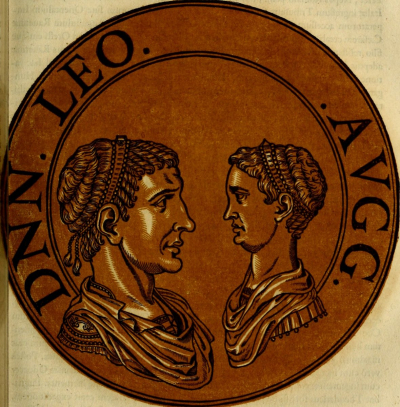Leo I (Greek: , translit. Len; c. 401 18 January 474), also known as "the Thracian" (Latin: Thrax; Greek: ), was Eastern Roman emperor from 457 to 474. He was a native of Dacia Aureliana near historic Thrace. He is sometimes surnamed with the epithet "the Great" (Latin: Magnus; Greek: ), probably to distinguish him from his young grandson and co-augustus Leo II (Greek: , translit. ho Mikrs, lit. "the Small").Ruling the Eastern Empire for nearly 20 years, Leo proved to be a capable ruler. He oversaw many ambitious political and military plans, aimed mostly at aiding the faltering Western Roman Empire and recovering its former territories. He is notable for being the first Eastern Emperor to legislate in Koine Greek rather than Late Latin. He is commemorated as a saint in the Eastern Orthodox Church, with his feast day on 20 January.
Leo II (Greek: Λέων, Leōn; c. 467 – November 474) was briefly Roman emperor in 474 when he was a child aged six or seven. He was the son of Zeno, the Isaurian general and future emperor, and Ariadne, a daughter of the emperor Leo I (r. 457–474), who ruled the eastern Roman empire. Leo II was made co-emperor with his grandfather Leo I on 17 November 473, and became sole emperor on 18 January 474 after Leo I died of dysentery. His father Zeno was made co-emperor by the Byzantine Senate on 29 January and they co-ruled for a short time before Leo II died in November 474. The precise date of Leo's death is unknown.

474Jan, 18
Seven-year-old Leo II succeeds his maternal grandfather Leo I as Byzantine emperor. He dies ten months later.
Choose Another Date
Events on 474
- 18Jan
Leo I the Thracian
Seven-year-old Leo II succeeds his maternal grandfather Leo I as Byzantine emperor. He dies ten months later. - 17Nov
Zeno (emperor)
Emperor Leo II dies after a reign of ten months. He is succeeded by his father Zeno, who becomes sole ruler of the Byzantine Empire.

 English
English  español
español  français
français  português
português  русский
русский  العربية
العربية  简体中文
简体中文 